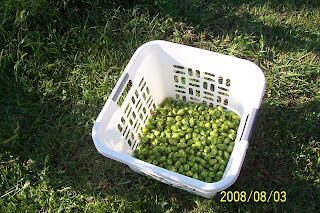So to summarize the year:
We prepared land and beds for around 100 potential plants, we ended up buying 70 total split up into the following:
Nugget x12 (all grew)
Cascade x12 (lost 2)
Centennial x 8 (lost 1)
Mt Hood x8 (all grew)
Goldings x8 (all grew)
Willamette x 8 ( lost 1)
Chinook x 10 (3 grew and 3 more eventually came out in greenhouse)
Sterling x 8 (lost 5 - 4 of those to animals)
The most voracious growers were the Nugget, Cascades, and Centennial , followed by Chinook and Goldings. Weakest were Sterling. Most yield - Cascade and Centennials followed by Nuggest and Chinook and Goldings.
Water was a challenge, the well was only repaired very late in the season , early August, and this was a setback for us.
We learned that hops are a gross feeder plant and the use of the rotten mulch as a soil enhancer was not very sensible as it tied up the Nitrogen and reduced growth. Once we realized this and fed the plants they took off, at first I used some "Miracle Grow", and after that used a balanced general fertilizer, spread liberally at base of the vines.
We chose to let any and all greenery grow this first season, so that we would get a big root system for future 
And dried them on racks in the container we organized from the farmer, sadly a set of large storms came through and blew the door off its hinges and damaged most of the picked hops
But the small $$ we all have invested so far will easily return itself next year, with a lb or two of hops to each stake holder if my projections are correct, the commercial guys get as much as 10lbs per bine on vigorous growing varaieties like Cascades and Nugget, and 3-4lbs per other varienties, with 2 bines per rootstock, we should be good next year.
We only overspent the budget by $75, and more than half the team worked all season including the clean up this last weekend.
Questions for next season:
1) Are all stakeholders happy to continue and prepared to continue to work or do we buy out the ones who were not able to help with the work
2) Do we plant more hops of the varienties that did work?
3) Do we abandon Sterling, as a bad example ?? Or do we try again and have better animal control ?
4) Do we install an irrigation system?
5) Do we mulch the circle centers for better grass and weed control ?
Please comment here or email me for any more information....
Rick
Monday, November 10, 2008
The first year in summary
at
11:13 AM
Subscribe to:
Post Comments (Atom)




4 comments:
I think we
-focus on the stronger breads.
-mulch the center area.
-add the irrigation system.
-focus planting in areas of better sunlight.
Donald Diemer
My Sterling plants did terrible as well, and had plenty of fertilizer and water all season. I would suggest we abandon them and focus on varieties that grow effectively.
I think we should:
-mulch the center
-add irrigation
-scrap the Sterling (mine didn't do well either.
Dan B.
I think we should...
-mulch the center
-add irrigation
-scrap the Sterling and plant a stronger variety for our area.
-Fill out the rest of the circles with more plants.
- Add another row, or set of circles.
- Design a better accountability system to track how much time folks are putting in based on their abilities.
Jason
Post a Comment